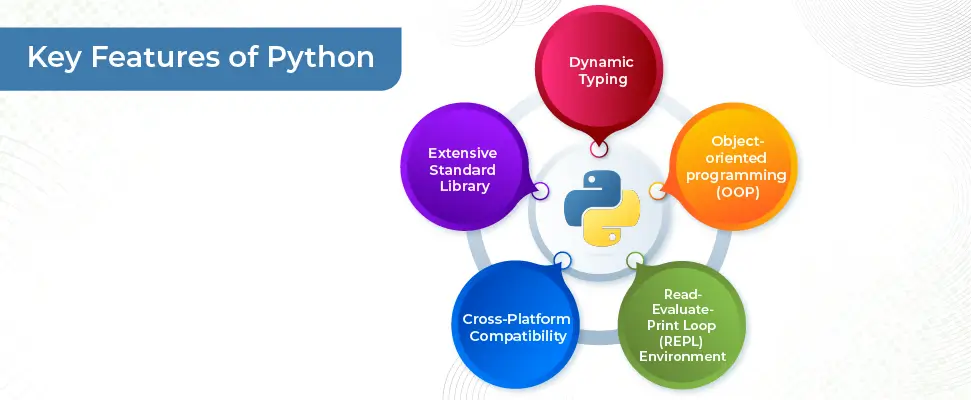Table of Contents
ToggleIntroduction
Backend is crucial to maintain the effectiveness and stability of the overall application. Regardless of how impressive your front end is, without a reliable backend, your application will stand weak. For any successful application, a robust backend is a must. In this article, we will explore between Node.js and Python which programming language is the best for backend development.

Don't miss out on your chance to work with the best!
Apply for top job opportunities today!
What is Python?

Python is a high-level, general purpose programming language developed in the year 1991 by Guido van Rossum, it is widely known for its versatility and multiprogramming interpreted language. Along with the support of object-oriented and functional programming, Python is suitable for rapid application development and scripting tasks.
Key Features of Python

- Dynamic Typing: You don’t need explicit type declaration in Python. Python development is faster with dynamic typing promotes and it increases code flexibility.
- Object-oriented programming (OOPs): It supports encapsulation, inheritance, and polymorphism through which a developer can organize the code and reuse it as an independent module. As a result, managing complex applications will be way easier.
- Read-Evaluate-Print Loop (REPL) Environment: This ensures rapid prototyping and experimentation. It then allows a developer to test their code and immediately access the output, which boosts productivity and development.
- Cross-Platform Compatibility: Python’s cross-platform allows it to reach a broader audience, making it a versatile choice for developers. Additionally, it lets developers write code and deploy it to any platform.
- Extensive Standard Library: It offers modules and packages that are enough to support the functionalities without the need for external dependencies.
Pros and Cons of Python
| Pros | Cons |
|---|---|
| Open-source and free-to-use | Needs constant validation for each variable |
| Concise and straightforward syntax | Performs slower than Java and C |
| Supports fast construction of prototypes for rapid software development | Consumes more RAM |
| Supports both object-oriented and procedural programming | Due to its simplicity, it’s often misused. |
| Automatically compiled during build time | Difficult to avoid runtime errors |
| Beginner-friendly | Its garbage collector cannot discard resources immediately |
| Easy to import and install free external libraries | Limited frameworks for mobile development |
| Write once and run anywhere | Not suitable for applications with complex large corporate database |
| Automatic memory allocation | Lacks high-quality and easy-to-use interface |
| Large active community support |
What Are the Benefits of Learning Python?

Python can be used for following use cases
- Agile Development: Python’s ability to quickly develop a basic version of an app or features pretty much helps in testing and validating in real-world scenarios. Additionally, its extensive library offers an extra perk for developers as it heavily saves time and effort during development. Besides its simplicity and clear syntax contribute to faster and more efficient workflow within the Agile framework.
- DevOps Scripts and Test Automation: Python is well-known for its ease of scripting and quick debugging, making it an excellent choice for scripting. With the built-in test library, PyUnit and Pytest allow smooth integration with various test frameworks. Besides, it ensures stability in managing the configuration within the DevOps environment.
- Portable Tools: Python is a wise choice for developers who work on various platforms. It is compatible with Linux, Windows, MAC, and platforms. The best part is its program executes in any system that has an interpreter-optimized.
- Data Science and AI: Thanks to its extensive libraries and active community, Python is the top choice in data science and AI fields. For seamless integration in natural language processing, it provides libraries such as TensorFlow and PyTorch can be used. NumPy and SciPy.
- Backend Web Development: Python with frameworks like Flask and Django offer a robust solution for server-side web development. These frameworks also come with templates and libraries for web design.
When to Use Python?
Python has one of the largest ecosystems in the programming community. It provides extensive libraries for data analysis tools, web frameworks, and test automation. Beginners can easily access its introductory resources and learn it. As compared to Node.js, Python is preferred by developers for its easiness of use, consistency, and stability. Moreover, it is used mainly in government projects, business applications, education, big data solutions, Desktop GUIs, and scientific applications.
When Not to Use Python?
- It is not a suitable option for low-level programming language.
- It doesn’t have the feature to create 3D graphics.
- Not the best option for creating a mobile app.
- Not a great choice for high-security applications.
Which Companies Use Python

What is Node.js?

Node.js is an open-source server cross-platform environment compatible with Windows, Linux, Unix, macOS, and more. Node.js is known for its efficient backend development. It was released in the year 2009 by Ryan Dahl and is commonly known for building scalable and performant apps that rely on Google Chrome’s JavaScript V8. Developers mainly use Node.js to create data-intensive real-time apps that run across distributed devices.
Read More- NodeJS Frameworks for App Development
Key Features of Node.js

- Asynchronous: It manages all the requests asynchronously using a single thread. Thus, the client side does not have to wait for data when requested. While the request is being processed in the CUP, the non-blocking technique prevents the I/O operation from getting blocked.
- Cross-Platform Compatibility: It can run on different operating systems and devices, so you can rest assured about its compatibility.
- Event Loop: Node.js takes each thread into an event, once all the events are processed associated callbacks are executed. Therefore, this event handling makes Node.js highly efficient in managing multiple lightweight requests.
- Developed in JavaScript: Most web applications are developed in JavaScript, which is widely used in industries. Developers who are already familiar with JavaScript can grasp Node.js quickly. Handling JSON files becomes way easier with the built-in function parse JavaScript.
- Scalability: Node.js can effectively handle as many requests due to its single thread and event-driven loop nature. The cluster module, on the other hand, simplifies load balancing across all the available CPUs.
Pros & Cons of Node.js
| Pros | Cons |
|---|---|
| Lightweight and fast delivery | Cannot process heavy CPU-bound task |
| Easy to learn and quick to adapt | Tons of nested callbacks create complexities in maintaining code |
| Fewer files and less code | Node Package Manager (NPM) lacks library support |
| Powered by V8 engine by Google | Unstable API and dependency on third-party module |
| Long-term support for enterprise | No monitoring system to identify the files and remove them from the library |
| Easy scalability | High demand with few experienced developers |
| Supports microservices architecture | Asynchronous code needs a deep understanding |
| Event-driven programming | Vulnerable to security threats and a steep learning curve |
| Provides electron or NW.js to create cross-platform support | Single-threaded can cause performance issues |
Benefits of Learning Node.js

- High-Performance in real-time applications: It uses single processor and IPsec architecture that can easily take workloads and maintain overall structure designs. Its architecture is capable of handling multiple requests and executing operations at faster rates without causing clogged RAM.
- Web Development: Using Node.js in your development can add many benefits such as scalability, speed, and performance. JavaScript is a go-to for front-end development, but Node.js made it a lot easier.
- Improves Response Time and Performance: Node.js supports nonblocking asynchronous architecture, making your apps supper performant without worrying about any negative factor.
- Quick Cache: Its lightweight cache module contributes to fast loading. Whenever the initial module receives the update, it directly stores the request within your application’s internal storage system.
- Advantage of Fullstack JS: Node.js is commonly used for server-side and client-side applications. So you don’t need to hire developers separately for backend and frontend development.
When to Use Node.js?
Node.js with an event-driven and non-blocking I/O model makes it a preferred choice to build data-intensive real-time applications. On top of that, it is built on Chrome’s JavaScript runtime, which is undoubtedly great for building scalable network applications. When compared with Python, Node.js beats it in terms of performance speed. With that being said, building heavy-load applications and e-commerce sites using Node.js is pretty easy. Furthermore, you can create I/O bound applications, data streaming applications, data-intensive real-time applications (DIRT), JSON APIs-based applications, and single-page applications.
When Not to Use Node.js?
- When your application needs to run on heavy computing and CPU-intensive tasks.
- It is also not best for a memory-intensive application that handles large data sets.
- Not the best option for a relational database backend server app, it would simply spoil it.
- Lastly, projects that require complex mathematical concepts and simulation.
Which Companies Use Node.js

Node.js vs. Python: Key Differences
| Factors | Node.js | Python |
|---|---|---|
| Extensibility | Comes with a framework such as Jasmin, Webpack with node as a base, Babel, and Log.io | Comes with a framework such as Flask, Django, Robot, and Web2py |
| Compatibility for | Both frontend and backend development | Applications that uses less code |
| Scalability | Supports multithreading and performs functioning through sets of modules | Doesn’t support instead uses a global interpreter lock |
| Error Handling | High-level performance with multithreading support | Easier to debug with robust troubleshooting |
| Interpreter | Uses JavaScript interpreter | Uses PyPy interpreter |
| Libraries | NPM package manager and extensive documentation | PIP package manager with clean and compact mode documentation |
| Preferred for | Building real-time app development | Creating complex software development related to scientific computation and AI/ML |
| Universality | Mainly used for backend development with cross-platform functionality support | Can be used for backend and frontend development and support cross-platform with the installation of a Python interpreter |
| Readability | Due to a callback hell, it reduces the readability | High readability code |
| Performance speed | Promotes high-speed performance in real-time applications | Promotes a single flow of code that results in slow performance |
| Architecture | Event-driven with asynchronous i/o, suitable for games and chatbots | Not event-driven and synchronous |
| Use Cases | 3D games, Content Management Systems (CMS), and an e-commerce store | DevOps and testing automation, government technical projects, big data, science, and engineering |
| Suitable | Ideal for memory-intensive processes | Best for large project development |
| Community | Open-source and contemporary with a large community | Older with huge community support |
Final Verdict
Node.js and Python boast unique strengths, but if you’re working on a data-intensive project with less code, Node.js is the ideal choice. It collects all the small components to form a large project, which is similar to creating a tree structure. But if your project requires numerous integrations of complex calculations with mathematical concepts, then look no further than Python.
FAQs
Node.js is compatible with multitasking and does not slow down the server. It is built on the fastest JavaScript engine that can easily handle a large flow of data. On the other hand, Python’s performance is not as fast as Node.js.
Python has a simpler syntax with a fewer lines of code for application development, which makes it easy for beginners to understand the concept. Whereas, Node.js might be difficult if you’re not familiar with the basics of JavaScript. On top of that, installation and documentation are quite complicated to follow due to its event-driven programming concept.
Python is a well-established language that boasts huge numbers of developer’s global community, on GitHub, it has 23.1K Fork and 44.7K Stars. On the flip side, Node.js has a 23.4K Fork and 87.4K Stars, making it a highly experienced community. Hence, Node.js takes the spot of the winner!
When it comes to maintaining the scalability of application programming languages needs the support of multithreading. In this case, Python lacks the support of multithreading. It uses Global Interpreter Lock which doesn’t allow multithreading. Because of this, Python does not excel in performing scalability. However, Node.js with a single thread easily handles and manages non-blocking I/O calls, making it highly scalable for developing applications. Moreover, it provides scalability for various servers with enhanced performance on a single server.
Take control of your career and land your dream job!
Sign up and start applying to the best opportunities!


